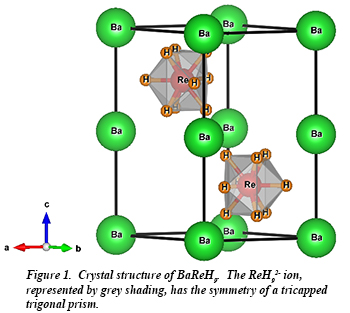 BaReH9 is the most hydrogen-rich inorganic salt discovered thus far, and is of great interest in the study of superconductivity in dense hydrides and also the metallization of hydrogen at high pressure. The unusual composition of this material suggests that investigation of its high pressure properties should offer a number of important insights into both of these critical issues.
BaReH9 is the most hydrogen-rich inorganic salt discovered thus far, and is of great interest in the study of superconductivity in dense hydrides and also the metallization of hydrogen at high pressure. The unusual composition of this material suggests that investigation of its high pressure properties should offer a number of important insights into both of these critical issues.
Under pressure, BaReH9 becomes metallic and then superconducting at above 100 GPa with a Tc of approximately 7 K. An important matter is how the crystal structure and associated properties evolve with pressure. In recent work, a group at Carnegie, including CDAC predoctoral student Eugene Vinitsky, carried out crystallographic and spectroscopic studies on a sample of BaReH9 up to 80 GPa to gain further insight into the high pressure behavior of this unique material.
 Diffraction measurements show that BaReH9 retains its hexagonal, ambient pressure structure (Fig. 1) up to 40 GPa. Above this pressure, the material appears to lose crystallinity, but Raman spectroscopy instead confirms a disordering of the ReH92- ion, which stabilizes the compound against dissociation. Optical absorption studies indicate the onset of an insulator to disorderd semimetal transition starting above 40 GPa with a gradual closing of the band gap. Based on results from Raman spectroscopy and x-ray diffraction studies, the authors conclude that the reluctant superconductivity in this material is linked to the pressure-induced disordering and crumpling of the ReH9 polyhedra [E. Vinitsky et al., J. Phys.: Condens. Matter 28, 505701 (2016)]
Diffraction measurements show that BaReH9 retains its hexagonal, ambient pressure structure (Fig. 1) up to 40 GPa. Above this pressure, the material appears to lose crystallinity, but Raman spectroscopy instead confirms a disordering of the ReH92- ion, which stabilizes the compound against dissociation. Optical absorption studies indicate the onset of an insulator to disorderd semimetal transition starting above 40 GPa with a gradual closing of the band gap. Based on results from Raman spectroscopy and x-ray diffraction studies, the authors conclude that the reluctant superconductivity in this material is linked to the pressure-induced disordering and crumpling of the ReH9 polyhedra [E. Vinitsky et al., J. Phys.: Condens. Matter 28, 505701 (2016)]
